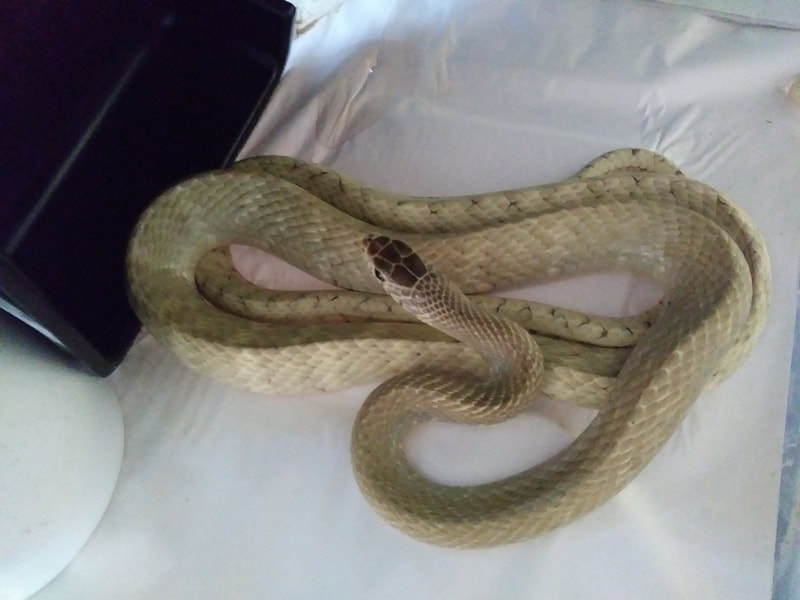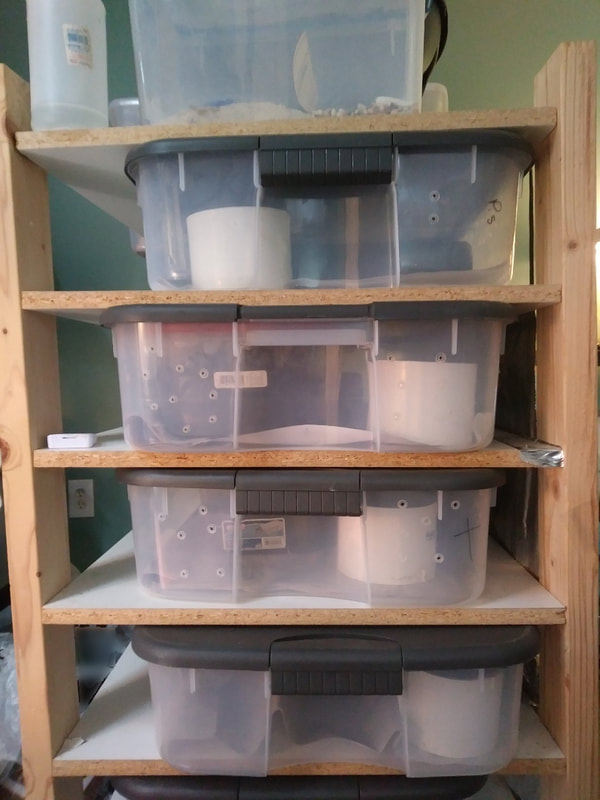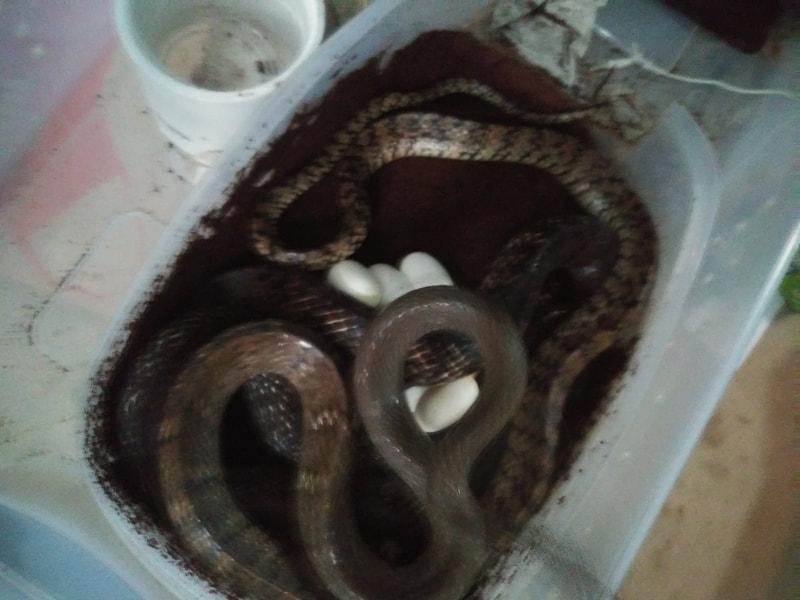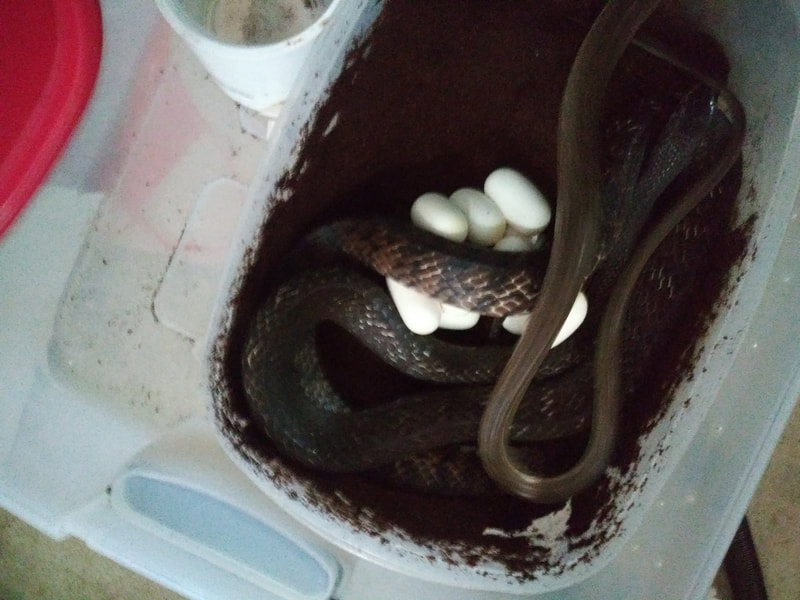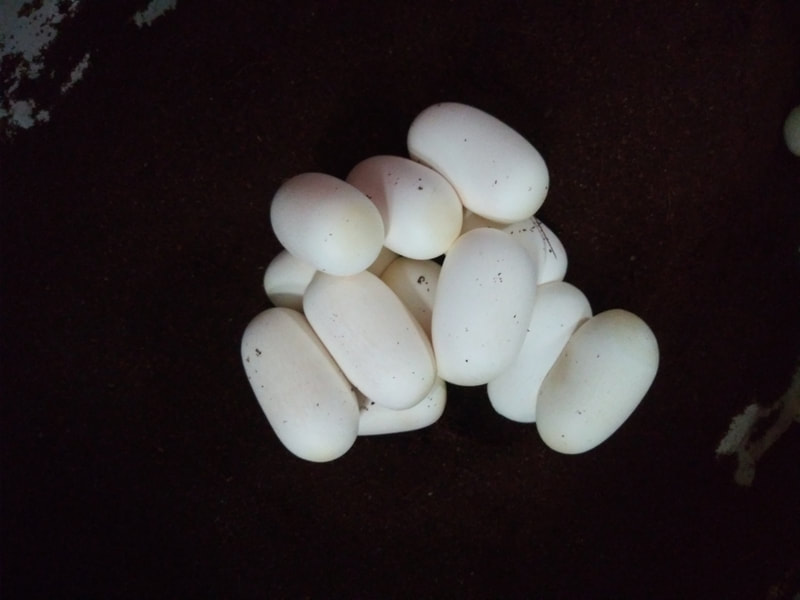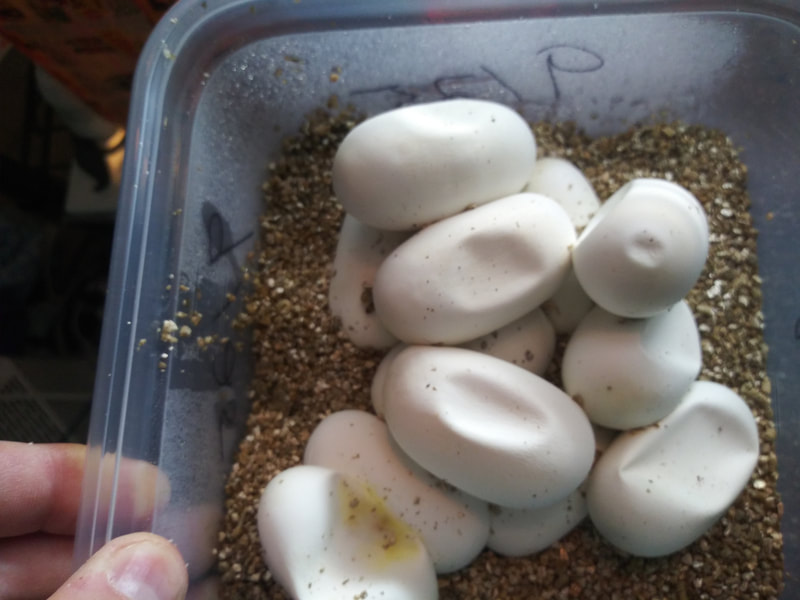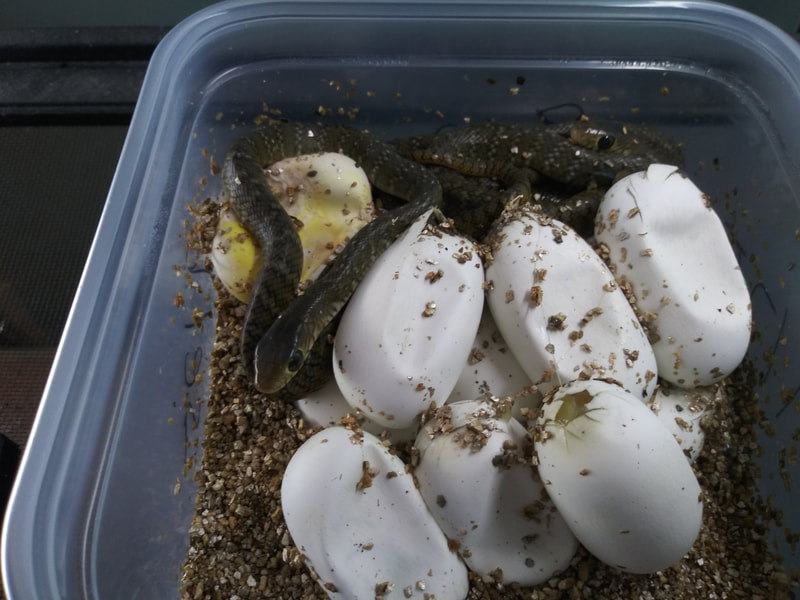This is a larger colubrid that is a real joy to keep. While they may hiss, especially at first, they tend to calm down and become fairly predictable although a very occasional nip cannot be ruled out. This is a good species for someone who has been keeping snakes for a while but probably not for a first snake as the babies sometimes need to be started on lizards, they get larger, and the hissing or occasional bite my intimidate a first time snake owner. A bite does not hurt very much, but it can be surprising. A sulphur phase was climbing on me and suddenly bit the lobe of my ear. It was more comical than painful.
These snakes are sometimes available as Wild caught, captive bred, or farm bred from other countries. There are a couple of morphs available, but I've only kept the normal phase and the much lighter colored sulphur phase (see photos). Potentially any of these can work well. Be aware that hatchling snakes may or may not take frozen thawed mice so be sure to find out from the breeder. In fact, they may or may not take live pinkie mice either. Several of my hatchlings would only take mice dipped in tuna juice or rubbed with a lizard, some would take a thawed lizard, and some would only take live lizards (ask for anoles or geckos on the smaller size if ordering online, they don't need to be tiny, but you don't want the largest examples either). Given that the snakes may have been wild caught or started on lizards, I would highly recommend performing a stool sample to check for parasites once the animals have stabilized and are eating. My wild caught animals had a small amount of hookwoms in their stool samples when I first obtained them.
As this is a larger species, it should be kept in a larger cage. I kept them in a rack using sterilite 1996 tubs and would suggest this is bare minimum size that should be used. A 4'x'2 enclosure should work well, too. Nothing fancy is needed but I recommend a large moist hide box which they will use for proper shedding and egg deposition, a 16oz deli cup placed inside a PVC coupler will provide water, and a dry hide should also be provided. Newspaper will work fine for a substrate. Place the water on the cool side so it will grow bacteria less rapidly and evaporate less frequently. I recommend changing the water every other day to keep it clean and make sure it is not empty. As far as temperatures go, I kept mine in relatively stable temperatures in the 70s. I recommend avoiding wide temperature swings with snakes in general and dialing in the snake room to be around the mid 70s and this species will do perfect under such conditions. Make sure sun shining in through a window cannot spike the temperatures in their cages/racks and have a plan in place if you live in a cold climate in case the power goes out. A 12" wide piece of heat tape set to the mid 80s under the far end of the warm side will provide them a basking spot should they want to use it, however, ensure they have plenty of room to move away from it as well. I highly recommend controlling this heat tape with a good quality thermostat such as a herpstat to protect both the snakes and your home and ensure the probe cannot be dislodged (shipping tape should help secure it). Ensure all the safety features are turned on and regularly check the temperatures with a high quality temp gun that is known to be accurate (not all are).
Breeding is not difficult, but the snakes need to be mature and wild caught snakes may need a period of time to adjust to captivity before breeding. It took about a year before my wild caught pair began breeding. Eggs were deposited in a large moist hide box and were incubated using the standard colubrid vermiculite mix. Once hatched, they can be moved to 6quart sterilite tubs with 1/8" holes drilled in them, a small water bowl and moist hide should be provided, newspaper works fine for a substrate that they will also hide under. A small piece of heat tape can be used to provide a warm spot, but make sure they can also move away from it and that it is properly controlled by a thermostat and that you've made enough holes for the tub to properly ventilate. As mentioned earlier, once they begin feeding, it is likely dietary preferences will vary. Some may feed on frozen thawed pinkies or tuna juice scented pinkies, some may take live pinkies, some may take lizard scented pinkies, but be prepped to provide live lizards for holdouts as some will starve themselves if this is not provided in my experience.
These snakes are sometimes available as Wild caught, captive bred, or farm bred from other countries. There are a couple of morphs available, but I've only kept the normal phase and the much lighter colored sulphur phase (see photos). Potentially any of these can work well. Be aware that hatchling snakes may or may not take frozen thawed mice so be sure to find out from the breeder. In fact, they may or may not take live pinkie mice either. Several of my hatchlings would only take mice dipped in tuna juice or rubbed with a lizard, some would take a thawed lizard, and some would only take live lizards (ask for anoles or geckos on the smaller size if ordering online, they don't need to be tiny, but you don't want the largest examples either). Given that the snakes may have been wild caught or started on lizards, I would highly recommend performing a stool sample to check for parasites once the animals have stabilized and are eating. My wild caught animals had a small amount of hookwoms in their stool samples when I first obtained them.
As this is a larger species, it should be kept in a larger cage. I kept them in a rack using sterilite 1996 tubs and would suggest this is bare minimum size that should be used. A 4'x'2 enclosure should work well, too. Nothing fancy is needed but I recommend a large moist hide box which they will use for proper shedding and egg deposition, a 16oz deli cup placed inside a PVC coupler will provide water, and a dry hide should also be provided. Newspaper will work fine for a substrate. Place the water on the cool side so it will grow bacteria less rapidly and evaporate less frequently. I recommend changing the water every other day to keep it clean and make sure it is not empty. As far as temperatures go, I kept mine in relatively stable temperatures in the 70s. I recommend avoiding wide temperature swings with snakes in general and dialing in the snake room to be around the mid 70s and this species will do perfect under such conditions. Make sure sun shining in through a window cannot spike the temperatures in their cages/racks and have a plan in place if you live in a cold climate in case the power goes out. A 12" wide piece of heat tape set to the mid 80s under the far end of the warm side will provide them a basking spot should they want to use it, however, ensure they have plenty of room to move away from it as well. I highly recommend controlling this heat tape with a good quality thermostat such as a herpstat to protect both the snakes and your home and ensure the probe cannot be dislodged (shipping tape should help secure it). Ensure all the safety features are turned on and regularly check the temperatures with a high quality temp gun that is known to be accurate (not all are).
Breeding is not difficult, but the snakes need to be mature and wild caught snakes may need a period of time to adjust to captivity before breeding. It took about a year before my wild caught pair began breeding. Eggs were deposited in a large moist hide box and were incubated using the standard colubrid vermiculite mix. Once hatched, they can be moved to 6quart sterilite tubs with 1/8" holes drilled in them, a small water bowl and moist hide should be provided, newspaper works fine for a substrate that they will also hide under. A small piece of heat tape can be used to provide a warm spot, but make sure they can also move away from it and that it is properly controlled by a thermostat and that you've made enough holes for the tub to properly ventilate. As mentioned earlier, once they begin feeding, it is likely dietary preferences will vary. Some may feed on frozen thawed pinkies or tuna juice scented pinkies, some may take live pinkies, some may take lizard scented pinkies, but be prepped to provide live lizards for holdouts as some will starve themselves if this is not provided in my experience.
